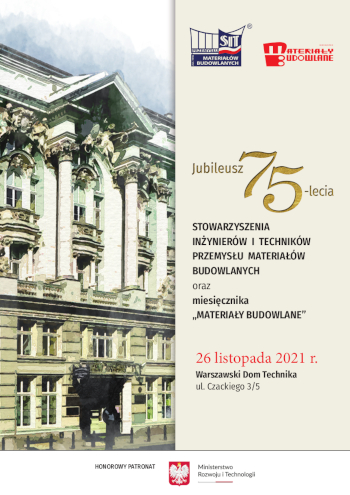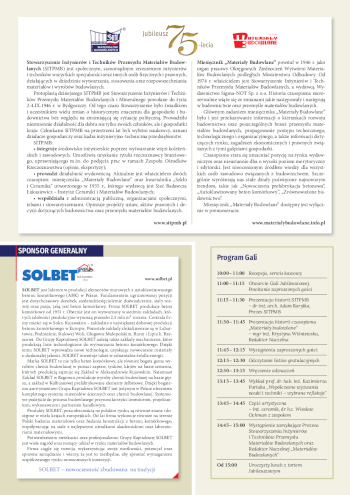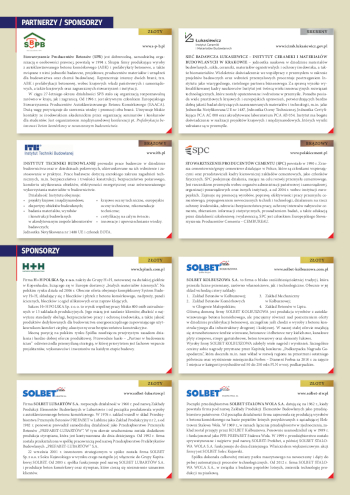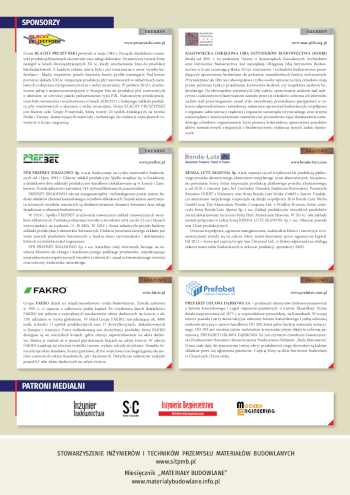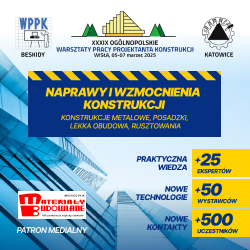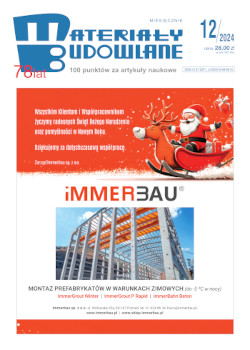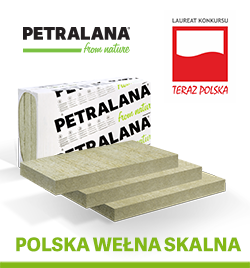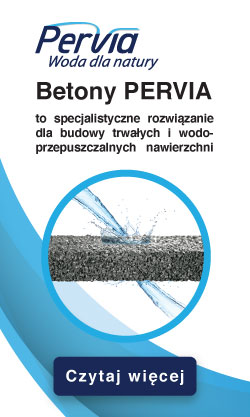Analiza opinii inwestorów i przedsiębiorstw branżowych dotyczących trwałości wzmocnienia podłoża w budownictwie drogowym
Open Access (Artykuł w pliku PDF)
citation/cytuj: Świtała M. Analysis of the opinions of investors and industry enterprises on the durability of ground reinforcement methods in road construction. Materiały Budowlane. 2024. Volume 628. Issue 12. Pages 144-154. DOI: 10.15199/33.2024.12.16
dr inż. Marcin Świtała, Instytut Badawczy Dróg i Mostów
ORCID: 0000-0002-4001-8948
Correspondence address: Ten adres pocztowy jest chroniony przed spamowaniem. Aby go zobaczyć, konieczne jest włączenie w przeglądarce obsługi JavaScript.
DOI: 10.15199/33.2024.12.16
Case study / Studium przypadku
Abstract. The article analyses the durability of various ground reinforcement methods in road construction. The aim of the study was to assess solutions such as stone columns, concrete columns, prefabricated piles, geosynthetics, and chemical and hydraulic stabilizations, while also taking into account the impact of reinforcement depth and the type of reinforced ground on their durability. The study is based on the analysis of opinions from investors and industry companies collected through electronic survey questionnaires. The results indicate that the most durable solutions are piles (CFA, prefabricated), soil replacement, and concrete columns, which significantly stand out in terms of the examined feature compared to other solutions. The key factors determining the durability of the applied methods turned out to be the type of ground and the depth of reinforcement. Proper adaptation of technology to specific soil conditions and correct design of reinforcement depth directly affect the effectiveness of the implemented solutions. Moreover, a comparative analysis showed that representatives of industry companies, in comparison to investors, expressed more positive opinions on all analysed research areas.
Keywords: durability of ground reinforcement; type of ground; depth of reinforcement; investors; industry enterprises.
Streszczenie. Artykuł analizuje trwałość różnych rodzajów wzmocnienia podłoża w budownictwie drogowym. Celem badania była ocena rozwiązań, takich jak kolumny kamienne, betonowe, pale prefabrykowane, geosyntetyki oraz stabilizacja chemiczna i hydrauliczna, przy jednoczesnym uwzględnieniu wpływu głębokości wzmocnienia i rodzaju wzmacnianego podłoża na ich trwałość. Badanie bazuje na analizie opinii inwestorów oraz przedsiębiorstw branżowych zebranych za pomocą ankiet elektronicznych. Wyniki wskazują, że najtrwalszymi rozwiązaniami są pale (CFA, prefabrykowane), wymiana gruntu oraz kolumny betonowe, które istotnie wyróżniają się pod względem badanej cechy w porównaniu z innymi rozwiązaniami. Kluczowymi czynnikami determinującymi trwałość zastosowanych metod okazały się rodzaj podłoża oraz głębokość wzmocnienia. Odpowiednie dostosowanie technologii do specyficznych warunków gruntowych oraz prawidłowe zaprojektowanie głębokości wzmocnienia bezpośrednio wpływają na skuteczność wdrożonych rozwiązań. Ponadto analiza porównawcza wykazała, że reprezentanci przedsiębiorstw branżowych bardziej pozytywnie wypowiadali się na temat wszystkich analizowanych obszarów badawczych niż inwestorzy.
Słowa kluczowe: trwałość wzmocnienia podłoża; rodzaj podłoża; głębokość wzmocnienia; inwestorzy; przedsiębiorstwa branżowe.
Literature
[1] Huat BB, Prasad A, Kazemian S, Anggraini V. Ground improvement techniques. London: CRC Press; 2019.
[2] Puppala AJ, Pedarla A. Innovative ground improvement techniques for expansive soils. Innov. Infrastruct. Solut. 2017. https://doi.org/10.1007/ s41062-017-0079-2.
[3] Correia AG, Winter MG, Puppala AJ. A review of sustainable approaches in transport infrastructure geotechnics. Transportation Geotechnics. 2016; 7: 21–28.
[4] De Borst R, Crisfield MA, Remmers JJ, Verhoosel CV. Nonlinear Finite Element Analysis of Solids and Structures. West Sussex: John Wiley & Sons; 2012.
[5] Neville AM. Properties of Concrete. Harlow Essex: Longman; 1995.
[6] Chastre C, Faria P, Neves J, Ludovico-Marques M, Biscaia H, Nunes L. Testing Durability on Construction Materials. In: Chastre C., Neves J., Ribeiro D., Neve, M.G., Faria P., editors. Advances on Testing and Experimentation in Civil Engineering. Cham: Springer; 2023. pp. 29–51.
[7] Li K, Zhang D, Li Q, Fan Z. Durability for concrete structures in marine environments of HZM project: Design, assessment and beyond. Cement and Concrete Research. 2019. https://doi.org/10.1016/j.cemconres.2018.08.006.
[7] Koerner RM. Designing with Geosynthetics. Bloomington: Xlibris Corporation; 2012.
[8] Nicholson PG. Soil improvement and ground modification methods. Kidlington: Butterworth-Heinemann; 2014.
[9] Kazemain S, Barghchi M. Review of soft soils stabilization by grouting and injection methods with different chemical binders. Sci Res Essays. 2012; 7(24): 2104-11.
[10] Chen H, Wang Q. The behaviour of organic matter in the process of soft soil stabilization using cement. Bulletin of Engineering Geology and the Environment. 2006; 65: 445–448.
[11] Zadehmohamad M, Luo N, Abu-Farsakh M, Voyiadjis G. Evaluating long-term benefits of geosynthetics in flexible pavements built over weak subgrades by finite element and Mechanistic-Empirical analyses. Geotextiles and Geomembranes. 2022. https://doi.org/10.1016/j.geotexmem.2022.01.004.
[12] Hsuan YG, Schroeder HF, Rowe K, Müller W, Greenwood J, Cazzuffi D, Koerner RM. Long-term performance and lifetime prediction of geosynthetics. In: Proceeding of EuroGeo 4-4th European Geosynthetics Conference. 2008.
[13] Górszczyk J, Malicki K. Badania deformacji geosiatki poliestrowej wykorzystywanej w inżynierii lądowej. Materiały Budowlane. 2024. https://doi. org/10.15199/33.2024.03.07.
[14] Keerthi N, Kori S. Study on improvement of sub grade soil using soil-reinforcement technique. International Journal of Applied Engineering Research. 2018; 13(7): 126–134.
[15] Jha JN, Singh H. Ground Improvement Techniques: Issues, Methods and their Selection. Guru Nanak Dev Engineering College Ludhiana (Punjab)- 141006. 2012.
[16] Shao W, Zhang W, Shi D, Xu Y, Liu E. Time-varying characteristics of the durability and lateral bearing behaviour of FRP bar-reinforced concrete piles in marine environments. Construction and Building Materials. 2021. https://doi. org/10.1016/j.conbuildmat.2021.124192.
[17] Purushotham Reddy B, Alagusundaramoorthy P, Sundaravadivelu R. Retrofitting of RC piles using GFRP composites. KSCE Journal of Civil Engineering. 2009. https://doi.org/10.1007/s12205-009-0039-2.
[18] Sen R, Mullins G. Application of FRP composites for underwater piles repair. Composites Part B: Engineering. 2007. https://doi.org/10.1016/j.compositesb. 2006.07.011.
[19] Mutaz E, Shamrani MA, Puppala AJ., Dafalla MA. Evaluation of chemical stabilization of a highly expansive clayey soil. Transportation research record. 2011. https://doi.org/10.3141/2204-19.
[20] Mackiewicz P. Ocena wpływu wybranego wzmocnienia podłoża gruntowego na trwałość konstrukcji nawierzchni drogowej z uwzględnieniem kryteriów deformacji podłoża gruntowego. Przegląd Komunikacyjny. 2014; 5: 27–30.
Received: 09.09.2024 r. / Artykuł wpłynął do redakcji: 09.09.2024 r.
Revised: 08.10.2024 r. / Otrzymano poprawiony po recenzjach: 08.10.2024 r.
Published:20.12.2024 r. / Opublikowano:20.12.2024 r.
Materiały Budowlane 12/2024, strona 144-154 (spis treści >>)




